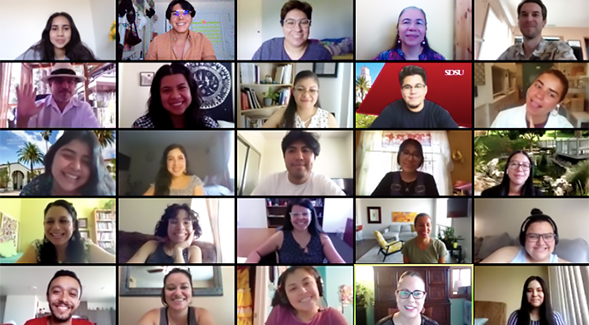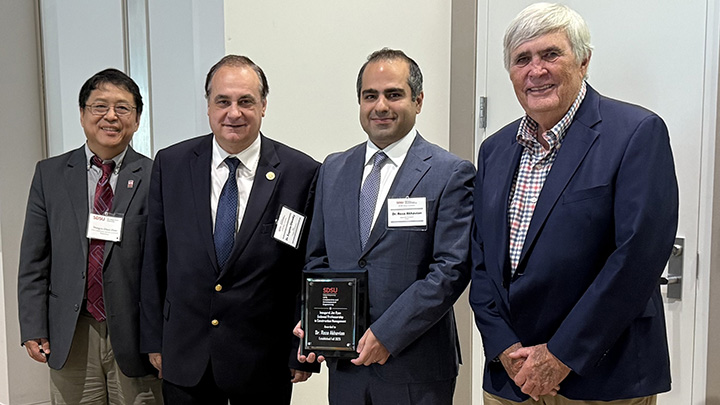Newest Cultural Resource Centers Overcome Challenging Launches
SDSUs three newest cultural resource centers continue to prioritize student success during the pandemic.

“We are foundational to the fabric of SDSU, collaborating with one another and across SDSU, ensuring students can show up authentically and find spaces to connect with their intersectional identities.”
The COVID-19 pandemic is not stopping San Diego State University’s three newest cultural resource centers from providing students from historically underrepresented backgrounds and their allies a space of their own.
Directors of SDSU’s resource centers are actively engaging with students through virtual sessions and programs while they await the opportunity to serve their communities face to face.
“It is certainly challenging, but not impossible, to open up a center without a physical space for convening,” said Virginia Loh-Hagan, faculty director of the Asian Pacific Islander Desi American (APIDA) Resource Center, which opened July 1.
“This means I have to get creative about building connections and getting the word out there that we are here and ready to serve,” she said. “I have to pivot in my approach in that I need to go to my communities instead of having communities come to me.”
The SDSU APIDA Resource Center kicked off September with welcome receptions, welcome socials and "Success from the Start" workshops and launched programming to support academics, mental health and identity development, Loh-Hagan said. In October, the center has organized events for Filipinx American History Month.
SDSU Accepting Applications for Fall 2021: Apply Now
Loh-Hagan and her colleagues acknowledged that the COVID-19 pandemic has made the new centers’ rollouts more difficult than they would have been otherwise.
The Latinx Resource Center opened Feb. 20, just weeks before SDSU moved to mostly virtual learning. Center director Yesenia Sanchez Garcia said the migration led to changed plans for both spring and summer.
“COVID-19 completely turned our plans and focus upside down,” she said. “We had to quickly shift gears and respond to the needs of students, as we knew Latinx students and other marginalized students would be especially impacted during this pandemic, which has further magnified existing inequities.”
Despite the shift, Sanchez Garcia and others said the centers were largely able to handle the transition. During spring, for example, the Latinx Resource Center launched a retention support project and contacted more than 450 Latinx students several times throughout eight weeks to personally check on how they were doing and to connect them with resources and services. September and October brought a flurry of events for Latinx Heritage Month.
The Latinx Resource Center is focusing its fall programming on four areas: academic success (the COMUNIDAD support program for first-year students), identity exploration and formation (the Joteria Sin Fronteras program for students who identify as LGBTQIA+ and Latinx), mental health and wellness (including a Spanglish support group), and social and racial justice.
“Though it has been a major challenge, I am proud of the work our team has been able to accomplish, in spite of these unprecedented challenges,” Sanchez Garcia said. “We were able to adapt quickly and effectively and have continued working on the foundation for the Latinx Resource Center.”
Christopher Medellin, director of the Native Resource Center, said the spring grand opening of the center’s new home in the Arts and Letters buildingwas postponed because of the pandemic, but the center found its footing in the months following the move to virtual learning. Partnering with the Native American Student Alliance, the center produced a week of events and programs for the Indigenous Peoples’ Week of Action, Oct. 12-16.
“As a newer center we were getting our feet on the ground and trying to establish a base set of services for students to access and that was disrupted,” Medellin acknowledged. “Moving forward, we are trying to make the best of the current situation, and we are really relying on students to meet us halfway so we can better serve some of their needs.”
Engaging students can be challenging in the virtual era, the directors agreed, but they said the work and purpose of the centers are too important to not make the extra efforts.
The centers are a key component of the university’s new five-year strategic plan, "We Rise We Defy: Transcending Borders, Transforming Lives," with a strategic priority to become a global leader in advancing diversity, equity and inclusion.
“It is important for SDSU to ensure the expansion of community centers focused on specific identities and communities, as these spaces provide critical support to students to ensure they not only succeed but also thrive at SDSU – academically, socially and mentally,” Sanchez Garcia said. “We are foundational to the fabric of SDSU, collaborating with one another and across SDSU, ensuring students can show up authentically and find spaces to connect with their intersectional identities.”



